Affordable Dual Core from AMD: Athlon 64 X2 3800+
by Anand Lal Shimpi on August 1, 2005 9:36 AM EST- Posted in
- CPUs
The Test
Our hardware configurations are similar to what we've used in previous comparisons. For this test, we focused on CPUs at or around the Athlon 64 X2 3800+'s $354 price point.AMD Athlon 64 Configuration
Socket-939 Athlon 64 CPUs
2 x 512MB OCZ PC3200 EL Dual Channel DIMMs 2-2-2-7
ASUS A8N-SLI Deluxe
ATI Radeon X850 XT PCI Express
Intel Pentium 4 Configuration
LGA-775 Intel Pentium 4 and Pentium D CPUs
2 x 512MB Crucial DDR-II 533 Dual Channel DIMMs 3-3-3-12
Intel 925XE Motherboard
ATI Radeon X850 XT PCI Express
Business/General Use Performance
Business Winstone 2004
Business Winstone 2004 tests the following applications in various usage scenarios:. Microsoft Access 2002
. Microsoft Excel 2002
. Microsoft FrontPage 2002
. Microsoft Outlook 2002
. Microsoft PowerPoint 2002
. Microsoft Project 2002
. Microsoft Word 2002
. Norton AntiVirus Professional Edition 2003
. WinZip 8.1
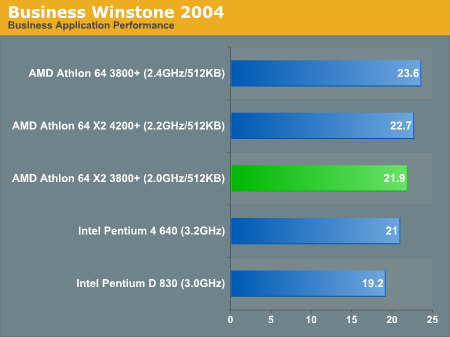
Office Productivity SYSMark 2004
SYSMark's Office Productivity suite consists of three tests, the first of which is the Communication test. The Communication test consists of the following:"The user receives an email in Outlook 2002 that contains a collection of documents in a zip file. The user reviews his email and updates his calendar while VirusScan 7.0 scans the system. The corporate web site is viewed in Internet Explorer 6.0. Finally, Internet Explorer is used to look at samples of the web pages and documents created during the scenario."
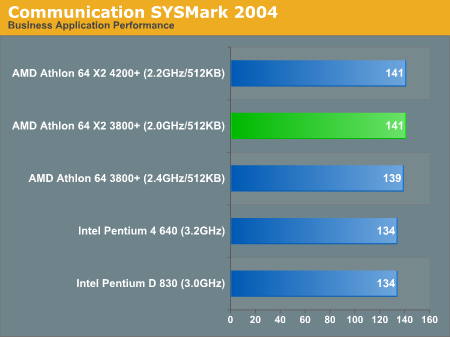
"The user edits the document using Word 2002. He transcribes an audio file into a document using Dragon NaturallySpeaking 6. Once the document has all the necessary pieces in place, the user changes it into a portable format for easy and secure distribution using Acrobat 5.0.5. The user creates a marketing presentation in PowerPoint 2002 and adds elements to a slide show template."
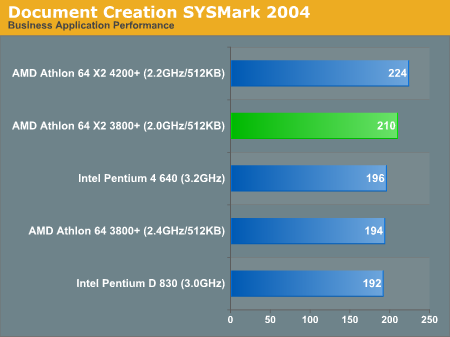
"The user opens a database using Access 2002 and runs some queries. A collection of documents are archived using WinZip 8.1. The queries' results are imported into a spreadsheet using Excel 2002 and are used to generate graphical charts."
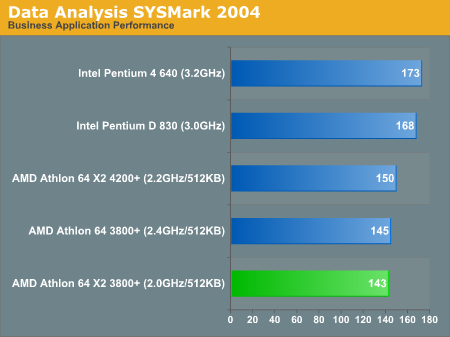
Microsoft Office XP SP-2
Here, we see in that the purest of office application tests, performance doesn't vary all too much. 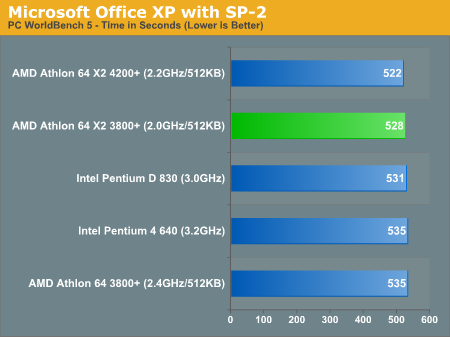
Mozilla 1.4
Quite possibly the most frequently used application on any desktop is the one that we pay the least amount of attention to when it comes to performance. While a bit older than the core that is now used in Firefox, performance in Mozilla is worth looking at as many users are switching from IE to a much more capable browser on the PC - Firefox. 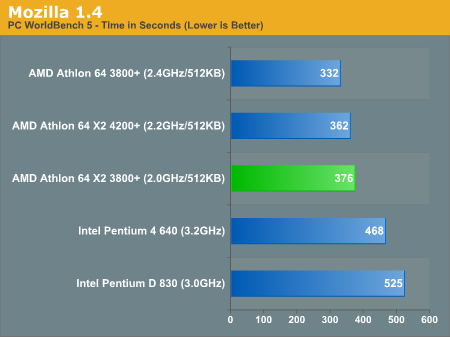
ACD Systems ACDSee PowerPack 5.0
ACDSee is a popular image editing tool that is great for basic image editing options such as batch resizing, rotating, cropping and other such features that are too elementary to justify purchasing something as powerful as Photoshop. There are no extremely complex filters here, just pure batch image processing. 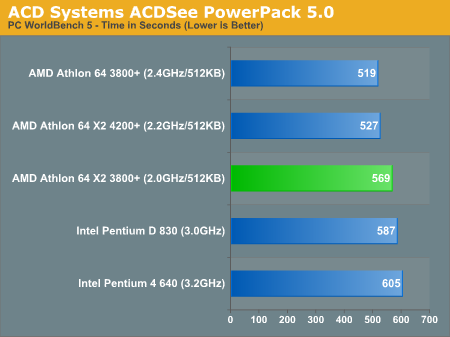
Winzip
Archiving performance ends up being fairly CPU bound as well as I/O limited. 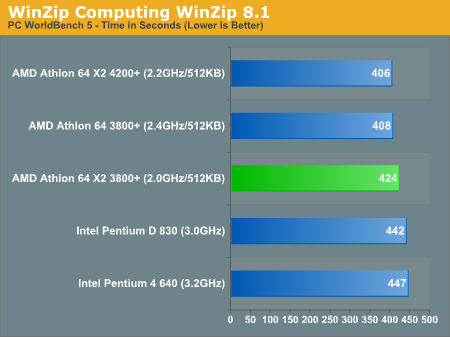
WinRAR 3.40
Pulling the hard disk out of the equation, we can get a much better idea of which processors are truly best suited for file compression. 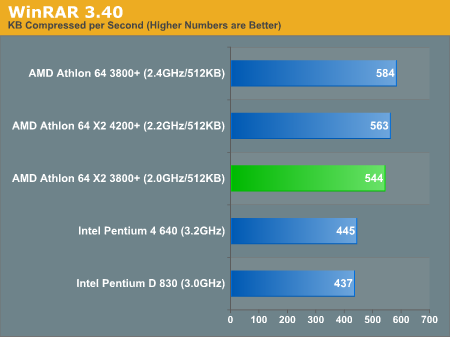










109 Comments
View All Comments
dougSF30 - Monday, August 1, 2005 - link
2.0 and 2.2 GHz parts with 512K L2 x 2 = 89W, whether "BV" (Manchester) OR "CD" (Toledo).2.2 GHz 1MB L2 x 2 and 2.4GHz 512K or 1MB L2 x 2 = 110W, whether "BV" (Manchester) OR "CD" (Toledo).
Once again, http://www.amdcompare.com/us-en/desktop/Default.as...">http://www.amdcompare.com/us-en/desktop/Default.as...
is useful. Select the X2 line.
yacoub - Monday, August 1, 2005 - link
p5:The Roxio VideoWave test in PCWorld’s WorldBench 5 suite completes 6 seconds quicker on the Pentium D 830 than it does on the Athlon 64 X2 3800+.
yacoub - Monday, August 1, 2005 - link
"In one of their strongest CPU paper-launches ever"HAHAHAHAH :)
dougSF30 - Monday, August 1, 2005 - link
"Strongest paper launches ever" ??? Face it, you guys blew it in your original X2 article, claiming there would be no retail availability until late this year. Turned out that in June anyone who wanted one could buy one from Newegg or Monarch.BTW, the 4200+ and 4600+ were Manchester (OPN core code: "BV", Rev E4) cores (147mm^2) when launched. Now there are also Toledo (OPN core code: "CD", Rev E6) versions, but they did not show up until recently.
Check the Desktop Processor Quick Reference Guide (and OPNs of parts sold since June from various vendors-- the 4200 and 4600 were "BV" Manchester parts):
http://www.amdcompare.com/us-en/desktop/">http://www.amdcompare.com/us-en/desktop/
(Select the X2 line)
masher - Monday, August 1, 2005 - link
Why no details on the testbed for each platform, specifically memory speeds used? It makes me wonder if the comparison used pricey low-latency ram for the X2 and bargain-barrel chips for the Pentium D..Also the article states "While AMD scales slightly worse than Intelin the MMCC Winstone and Multitasking 1 tests, AMD scales a lot better in the last two tests...". In one of those tests, AMD's "slightly worse" is 5.7%...whereas AMDS "a lot better" result on one of the other two was a measly 2.9%.
A 5.7% drop is "slightly worse", but a 2.9% increase is "a lot better"? What's funny is this obvious distortion was likely done subconsciously by the author, in his desire to boost his favorite.
When are you fanboys going to learn that processors are TOOLS. Use the best one for the job at the time...don't fall in love with them. If you were plumbers, you'd probably be masterbating each night with your pipe wrenches.
Houdani - Monday, August 1, 2005 - link
Eh? Where did you find the 5.7 and 2.9 numbers? Did the tables change since this comment was posted?For the numbers in question (table 1 on page 4) I'd rate the processors...
MMCC Winstone -- no advantage
Multitask 1 ---- Intel advantage (modest win) (+9.1%)
Multitask 2 ---- no advantage
Multitask 3 ---- AMD advantage (big win) (+29.3%)
Remove the MMCC and Multi_2 benches, and the comments are quite appropriate. Intel scales slightly better in Multi_1, while AMD scales a lot better in Multi_3.
justly - Monday, August 1, 2005 - link
I found (at least) some of the conclusions about “AMD's Efficiency Advantage?” bogus.The biggest error (and most obvious) is in the Winstone multitasking test 1, where the author commented that AMD is “significantly worse in the Multitasking 1 test”.
In that test duel core had no benefit because a single core AMD processor can handle that test without the need for a duel core. Looking at the actual numbers for that test on the “Multitasking Performance” page not only shows that the faster clocked single core AMD scale almost perfectly (based on clock speed) against its slower clocked duel core counterpart but it has the top performance in that test. Without looking at both the actual score and the percent of increase what is being proven has nothing to do with the “efficiency” of a duel core, but more to the point it shows how “inefficient” a single core is in that test. The 0% increase by moving from single core AMD to duel core AMD only goes to show how “efficient” the single core AMD is in that test scenario.
masher - Monday, August 1, 2005 - link
Aside from being near-intellible, this reply is far off the mark. No matter how efficient a single processor is, one expects two processors to be somewhat faster tha one. If this wasn't true, what would be the point of "duel-core" [sic] processors in the first place?There is no magic "100% efficiency" level for single a processor that cannot be exceeded. Even if there were, that efficiency would translate to the second core, making it faster as well. Two should be faster than one.
The efficiency being measured is not of the core itself, but of the scalability of multiple cores vs. a single one. In this particular case, there is a "100% efficient" standard-- linear scaling. If two cores run a benchmark twice as fast as one, then the dual-core implementation is 100% efficient...regardless of how efficient or ineffecient the actual cores themselves are.
Read the above carefully and consider it. It's not difficult to understand.
justly - Tuesday, August 2, 2005 - link
You can expect two processors to be faster than one, but that isn’t always true.What you failed to understand is the single core AMD processor is not limited by processing power in the Winstone multitasking test 1, so by adding the second core there is basically nothing for the second core to do, hence no performance increase.
Because of this it is inappropriate for the auther to gauge scalability for this test in a negative context as he did when he said “significantly worse”. In fact the worse a single core processor performs the more likely it will see a higher scaling when a second core is added because there is more work for the second core to process.
masher - Tuesday, August 2, 2005 - link
> "You can expect two processors to be faster than one, but that isn’t always true..."Of course it isn't. That's the purpose of this test...to determine the performance increase, if any.
> "...The single core AMD processor is not limited by processing power in the Winstone multitasking test 1, so by adding
> the second core there is basically nothing for the second core to do, hence no performance increase."
Oops, wrong again. You should have realized this simply from the fact that a higher clocked single-core A64 runs the benchmark faster. Claiming this test isn't even slightly CPU-bound and thus the poor result "isn't AMD's fault" is nonsense.
> "...the worse a single core processor performs the more likely it will see a higher scaling when a second core is added..."
Only for tests that are disk or memory-bound. And given the current differences in memory subsystems between AMD and Intel and the highly-integrated nature of AMD's memory controller, the "efficiency" of AMD's dual-core implementation is pretty much indistinguishable from the efficiency of their memory system.
So that just leaves highly disk-bound tests...which these tests were not. Even if they were, the results would still be valid. After all, if a single-core A64 runs as fast as possible due to disk constraints, then why should anyone spend more money on a dual-core chip?
Of course, one core of an X2 3800 is not nearly so fast as to run any of these benchmarks "as fast as theoretically possible". If multiple cores don't score higher, then its indicative of an underlying scaling issue, either with the chip or the test itself. Any other conclusion is nothing more than apologism and wishful thinking.